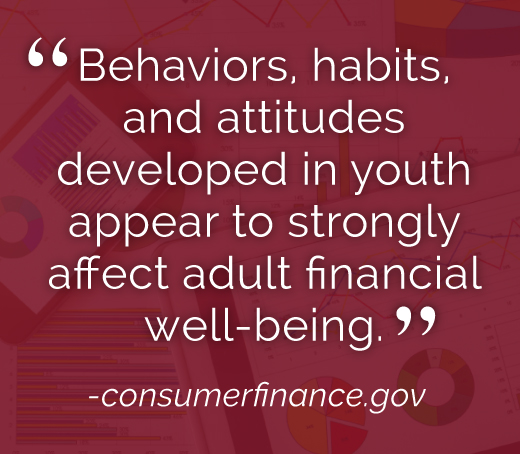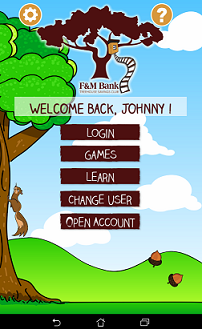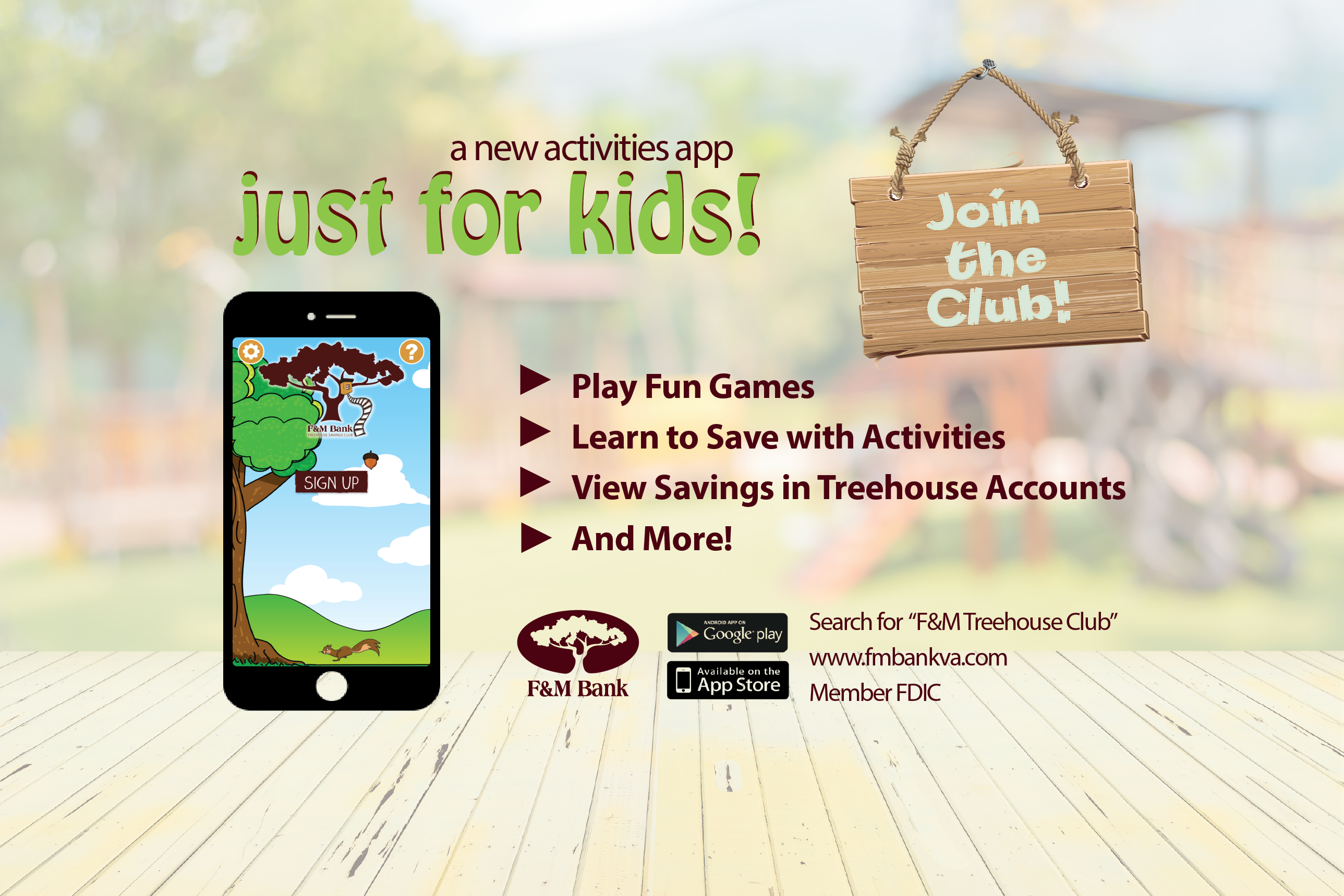How To Teach Kids About Money: A Comprehensive Guide
Explaining money to kids can feel challenging, especially if your own finances aren’t perfect. And it doesn’t help that many of our purchases are made online or with debit and credit cards at the store. Kids don’t see their parents budget and make purchases with cash and checks as much as they used to. However, teaching financial literacy to our kids is more important than ever. Luckily, it doesn’t have to be difficult or boring. F&M has scoured the best sources out there to bring you this comprehensive guide to teaching kids to save money, budget, and develop other positive financial habits. From modeling good habits to playing a fun game or app, these tips will help kids of all ages develop a strong financial foundation. You might even learn a few things yourself along the way.
How To Teach Kids About Money By Modeling Positive Habits
Where do children learn about money? It probably won’t surprise you that parents are the most important influence. After all, children learn most things from their parents. Money is one thing you shouldn’t wait to talk about–research shows that kids’ financial behavior may already be shaped by the time they start first grade. Here are five things you can do now to model healthy financial behavior for your kids and help them develop a positive attitude toward saving and spending money.
- Let them see you save money. It doesn’t take a lot of parenting experience to realize “Do as I say, not as I do” is rarely if ever an effective teaching strategy. Your kids are watching and listening more than you realize and they will parrot your habits and behaviors back to you. So if you want to encourage children to save money you need to let them see you save. While most of your savings might be tied up in a 401k or other online accounts, you can establish a simple savings jar in a prominent place in your house. Drop your spare change in when your child is watching or let them throw the coins in. You don’t have to make a big deal of it each time, but now and then let the jar inspire a conversation about why you are saving, what it’s for, and how it can help you in the future.
For example, “When we put away our spare change every day it eventually adds up. By the time we go to the beach next summer we’ll have enough saved to pay for a special experience like dinner in our favorite restaurant.” Or, “Do you remember when our car got a flat tire last month? Car repairs can be expensive, and we don’t know when something will break. I’m saving my change in this jar so I’ll be prepared the next time something breaks.”
- Turn everyday errands into teachable moments. Whenever your kids are with you at the grocery store, gas station, and other routine errands, explain the choices you’re making and how you pay for purchases. Many people use debit and credit cards instead of checks or cash, but you can still explain that a debit card is a method of paying with the money in your bank account, whereas a credit card is a way to temporarily borrow money and pay it back at the end of the month.
Do you use a certain credit card to accrue points or cash back? You can explain that, too; even young children can grasp the idea of rewards. You can also work in little lessons like, “I use my credit card to get rewards, but I always pay the balance at the end of the month.” Or perhaps you don’t use credit cards at all after finally getting out of debt, in which case you could say something like “Mommy and Daddy always pay with our bank account because we don’t want to spend more than we have.” Keep it simple, but don’t be afraid to talk about all aspects of money management when it comes up.
- Let your kids watch you write a check. Preschool-age children are very interested in letters, numbers, and writing. Although most people don’t write as many checks as they used to, there are still occasions for it. Have your kids watch as you point out the different parts of a check–”Here’s the date, here we write the name of the person we’re giving the money to…this is the memo space where we can write what the check is for. Do you know what this is for? We’re paying your piano teacher for one month of lessons.”
- Have your child press the buttons at the ATM. It’s a universal truth that kids love to push buttons. Ask your child to help you at the ATM and explain each step of the process. “First we insert our debit card. Then we type our password. Here are the different amounts of money we can take out. I’m getting money for our trip to the zoo. What do you think we’ll need to pay for there?”
- Help your child differentiate between needs and wants. It’s natural to feel frustrated when your child begs for something at a store. Of course, that doesn’t mean you should give in. But a little empathy can go a long way and help your kids recognize the difference between things they need and things they want. After all, adults aren’t immune to wanting things. At the grocery store you can say things like, “We need to buy food so we can take care of our bodies with healthy meals and snacks. Mommy likes ice cream, too, but that is something we want, not something we need. We can choose to spend our extra money on something we want like ice cream, or save it for something bigger.” Or, “We came to Target because you outgrew your sneakers and need a new pair. There are extra things Daddy would love to buy at Target, too, but today we are just going to buy what we need.”
- Be honest. Kids can usually tell when you’re trying to brush them off. If you try to get away with a vague or untruthful answer, you’ll probably just be met with a string of “why?” Instead of saying “we don’t have enough money to buy that toy,” if the truth is that you simply don’t want another toy in your house, frame your answers as a choice. Choices empower people of all ages. “I’m choosing not to buy that toy today because I’d rather spend the money on a fun experience like going to the movies with you.”
DIY Activities For Teaching Kids And Students About Money

Parents and teachers can help kids learn about money management while also sneaking in a few Math lessons with these fun and easy-to-do activities.
- Turn a few envelopes into a fun budgeting lesson. You’ve probably heard of the envelope budgeting system for adults, in which you divide your money in cash into envelopes earmarked for specific expenses as well as fun. Add a few crayons and you’ve got a fun activity for kids that helps them understand budgeting and saving in a concrete, tactile way.
Your child doesn’t need to have as many envelopes as an adult would. Let kids think of a few items they’d like to save up to buy. On each envelope, they draw a picture of the desired object or experience. You can even differentiate between short-term and long-term goals. For example, an expensive Lego set will take longer to save for than a trip to the ice cream parlor. As they receive money they can decide how to allocate it between their savings goals. That also teaches prioritizing and weighing instant gratification against long-term goals.
- Make a money chart. Another way to visualize saving is to create a chart. With a piece of posterboard, a few markers, and a sheet of star stickers–all available at the drug store–you can help your child figure out how long it will take to reach various savings goals based on the cost of the item and the amount of money they can expect to receive over the next few months, whether from an allowance or holiday gifts. Each time your child saves a certain amount of money toward their goal, they get to put a sticker in the box, a tracking method that never fails to satisfy. Seeing the chain of stickers will only encourage them to keep going.
- Role play with a toy cash register. This is a classic toy that comes in many different models. Find one with coins and cash in a drawer that opens and shut. That way, aside from the fun of pressing the buttons, kids can learn about money through play. As the adult, you can guide the role play from transactions at the grocery store to the bank. Kids will grasp the idea of handing over money in exchange for an item or service, getting change, and figuring out how much they have left to spend.
Games Make It Fun To Explain Money To Kids

When your kids grow out of the imaginative play stage, you can still make learning fun with board games and online activities.
Online Games
- The Rich Kid Smart Kid online games are free, fun, and help to teach basic financial skills such as saving, making money, and dealing with debt.
- Make Change Game is a free online game that teaches basic Math as well as the concept of making a purchase and receiving change.
- Education.com offers several free Math games involving money.
- ABCYA.com also has a free counting money game for different ability levels.
Board Games
- Payday is a classic budgeting board game for ages eight and up.
- Lakeshore Allowance Board Game teaches kids how to make good decisions with the money they receive.
- The Money Bags board game comes with realistic-looking bills and coins.
- Loose Change teaches kids about different combinations of coins that add up to a dollar.

Money Apps For Kids
In addition to online games, here are some educational money apps for kids and teens that make learning good financial habits fun.
- Green$treets: Unleash the Loot is a free money management app for ages five to ten.
- Savings Spree ($5.99) is a financial literacy app for kids seven and older.
- Celebrity Calamity is a free app that takes a playful approach to budgeting.
- Kids who have their own savings account can download their bank’s mobile app to keep track of their money in real time. F&M Bank also offers a special app just for kids as part of our Treehouse Savings Club. They can access their savings account, play games, and learn important financial concepts. Download the free app for iOS or Android.
Books That Teach Kids About Money

Reading to your child is a great opportunity to bond…and teach them essential money management skills. Here are our favorite selections for readers of all ages featuring beloved characters as well as new ones.
- The Berenstain Bears’ Trouble With Money by Stan Berenstain
- Just Saving My Money by Mercer Mayer
- Amelia Bedelia Means Business by Herman Parish
- Alexander, Who Used To Be Rich Last Sunday by Judith Viorst
- Curious George Saves His Pennies by Margaret Rey
- Those Shoes by Maribeth Boelts
- One Cent, Two Cents, Old Cent, New Cent by Bonnie Worth
- A Chair For My Mother by Vera B. Williams
- Bunny Money by Rosemary Wells
- The Money Savvy Student by Adam Carroll
- Not Your Parents’ Money Book by Jean Chatzky
- What All Kids Should Know About Saving and Investing by Rob Pivnick
Practice And Reward
At the end of the day, one of the best ways to learn is through practice. Help your child open their own savings account so they can put money away and develop a relationship with a local bank. You can even offer to match a certain percentage of your child’s deposits, much like an employer matches an employee’s 401(k) contributions.
As a community bank, F&M cares about teaching financial literacy to the next generation. Our Treehouse Savings Club gives school-age kids the opportunity to have their own bank account with no minimum balance or maintenance fees. They even earn interest on their savings. The program also comes with a piggy bank, monthly prizes, and other fun extras. Visit your nearest F&M Bank location to learn more and sign up for the Treehouse Savings Club today.

 We have been made aware of an unsolicited text and phone call scam circulating through our area. Please DO NOT click any links sent to you via text.
We have been made aware of an unsolicited text and phone call scam circulating through our area. Please DO NOT click any links sent to you via text. 



